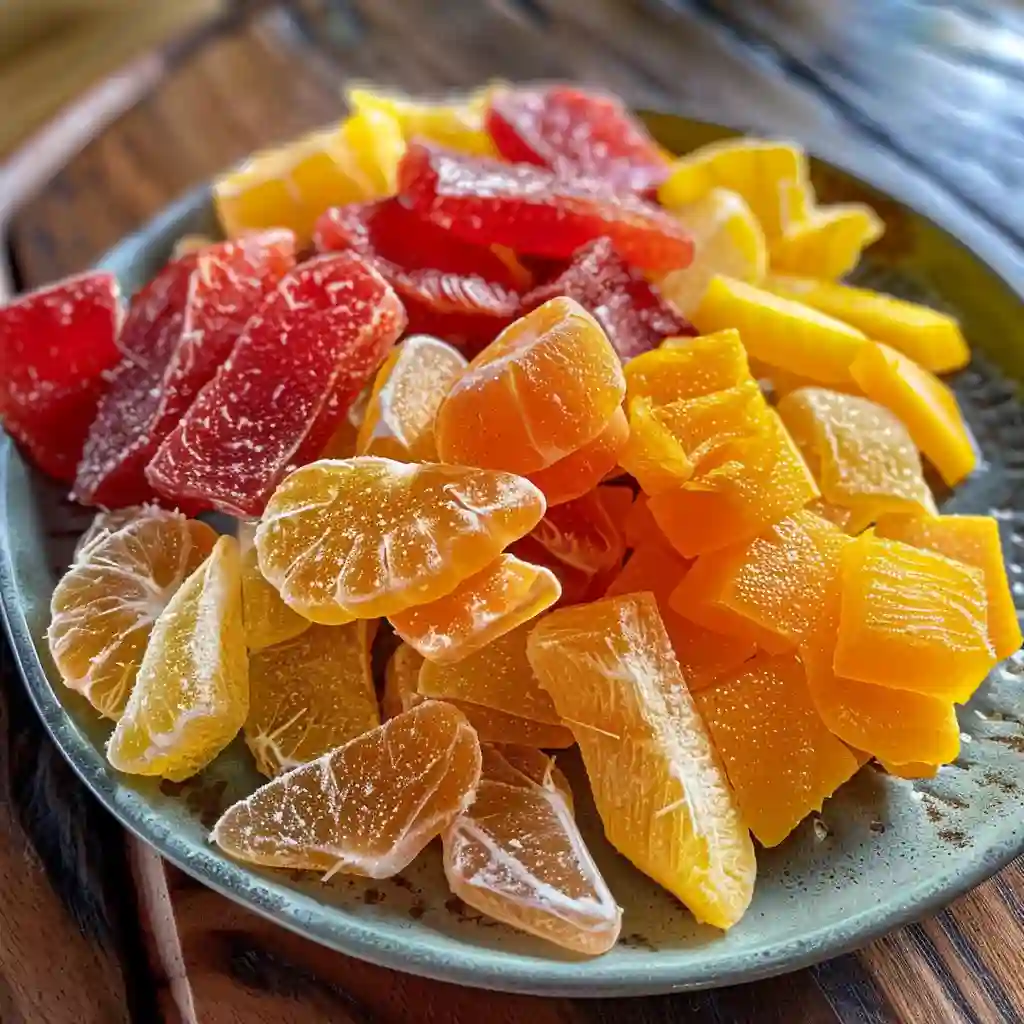When I first stumbled into the art of preserving fruit in sugar, I never imagined it would turn into one of my favorite kitchen obsessions. That first candied fruit hack—a trial with leftover orange peels on a rainy Sunday—was the sweet accident that started it all. I had no plan, just curiosity and a whole lot of sugar.
What followed was years of testing, tasting, and (yes) cleaning up sticky messes. This guide is a collection of my best lessons, from beginner mistakes to little tricks that changed everything. Whether you’re prepping a festive fruitcake, upgrading your dessert game, or just craving a chewy, jewel-toned snack, the tips in this candied fruit hack guide will help you do it the right way.
Inside, you’ll learn how to pick the right fruit, master syrup textures, troubleshoot common problems, and discover clever ways to chop candied fruit without turning your counter into a glue trap. We’ll explore what fruits can be crystallized, which tools make things easier, and how to add bold flavors like ginger, lime, or even chili.
Even if your first batch flops, don’t worry. I’ve been there—and I promise, once you get the hang of it, candying fruit will be one of the most satisfying skills in your kitchen.
Don’t miss our Tanghulu Candied Fruit Skewers recipe if you’re craving a crunchy twist on classic candied fruit techniques.
Let’s get sweet and sticky—in the best way possible.
Table of Contents
Understanding the Magic of Candied Fruit
What Is Candied Fruit and Why You Should Try It
If you’ve ever wanted to preserve fruit in a way that’s both delicious and beautiful, the Candied Fruit Hack is where you start. This method transforms fresh fruit into chewy, jewel-toned bites by simmering them in sugar syrup and drying them until glossy and firm—or perfectly sticky, depending on your style.
But this isn’t just about sugar and shine. For centuries, candied fruit has been a highlight in festive recipes worldwide—from Italian panettone and British fruitcake to Chinese tanghulu and Moroccan orange peels. The Candied Fruit Hack makes this ancient preservation method accessible to anyone, even in a small kitchen.
Here’s why you should try this at home:
- It’s inexpensive, easy, and incredibly satisfying
- Helps reduce food waste using citrus rinds or soft fruit
- A blank canvas for spices, extracts, and even chili
- Great for edible gifts or colorful dessert garnishes
Whether you start with orange peel or try your hand at mango, the Candied Fruit Hack turns ordinary fruit into something unforgettable.
The History and Cultural Roots of Fruit Candying
Fruit candying goes back thousands of years. In ancient Persia and China, fruit was preserved in honey long before refined sugar became common. As sugar spread through the Middle East and Europe, candying evolved into an elite culinary art. By the Renaissance, candied fruit symbolized luxury—served at royal feasts and holiday banquets.
My love for the Candied Fruit Hack began on a winter day in Fez, Morocco. A vendor offered me a glossy slice of citrus—sweet, tangy, and spiced with clove. That moment connected me to centuries of tradition through one tiny, perfect bite.
Today, you can bring this time-tested method into your home with nothing more than a saucepan, sugar, and a little patience. That’s the beauty of the Candied Fruit Hack.
Print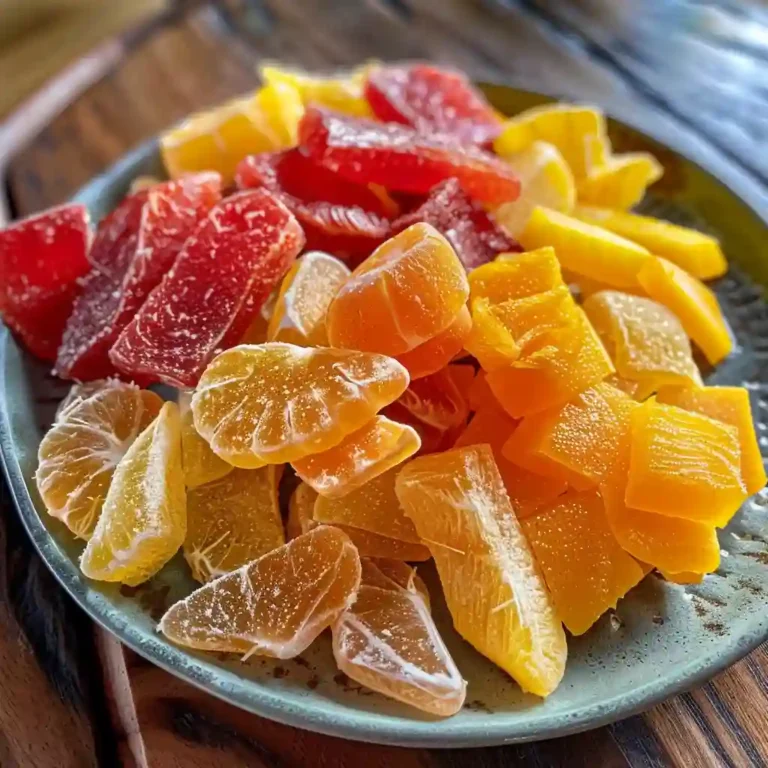
Candied Fruit Hack: The Ultimate Guide to Sweet Success
A deeply traditional and versatile treat, homemade candied fruit is chewy, jewel-toned, and packed with customizable sweetness, perfect for gifts, baking, or snacking.
- Total Time: 1 hour 30 minutes
- Yield: 10 servings 1x
Ingredients
- 4 large oranges (or lemons, grapefruit)
- 2 ripe but firm mangoes
- 3.5 cups granulated sugar (plus more for coating)
- 1.5 cups water
- 2 tsp lemon juice
- Optional: cinnamon stick, clove, 1 tbsp lime juice, 1/2 tsp chili flakes
Instructions
- Peel citrus fruits into wide strips, avoiding too much white pith. Peel and slice mangoes into thick strips.
- Boil citrus peels in water for 10 minutes. Repeat twice with fresh water to reduce bitterness.
- In a saucepan, combine 2 cups sugar, 1 cup water, and 1 tsp lemon juice. Simmer citrus peels on low for 45–60 minutes until translucent.
- In another pan, combine 1.5 cups sugar, 0.5 cup water, 1 tbsp lime juice. Simmer mango strips for 30–35 minutes until glossy.
- Remove fruit with a slotted spoon. Dry on a rack for at least 6 hours or in a 150°F oven for 1–2 hours.
- Optional: Toss dried fruit in sugar. Sprinkle mango with chili flakes for extra flavor.
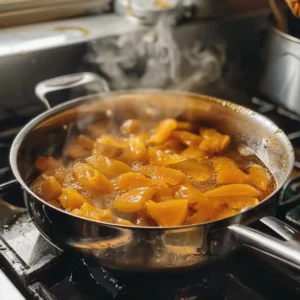
Notes
Store candied fruit in airtight containers at room temperature for up to 8 weeks. For longer shelf life, freeze tightly wrapped pieces.
- Prep Time: 30 minutes
- Cook Time: 60 minutes
- Category: Snack
- Method: Stovetop
- Cuisine: Global
Nutrition
- Serving Size: 1 portion
- Calories: 180
- Sugar: 36g
- Sodium: 5mg
- Fat: 0g
- Saturated Fat: 0g
- Unsaturated Fat: 0g
- Trans Fat: 0g
- Carbohydrates: 45g
- Fiber: 2g
- Protein: 0g
- Cholesterol: 0mg
Must-Have Ingredients and Tools for Any Candied Fruit Hack
Essential Ingredients for a Perfect Candy Coating
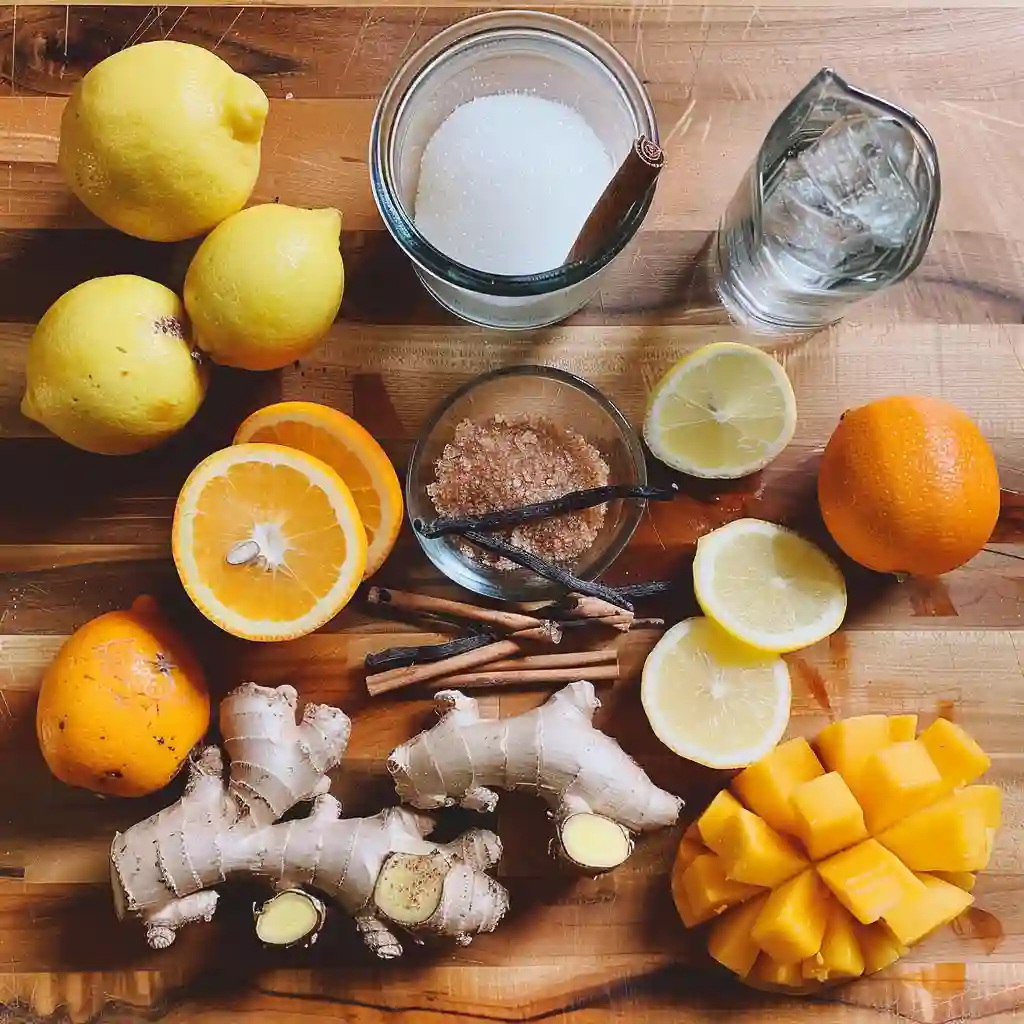
When it comes to nailing the perfect candied fruit hack, the magic starts with the basics. You don’t need fancy ingredients—just quality ones. Here’s what I always keep on hand when candying fruit at home:
- Fruit: Go for firm fruits like oranges, pineapples, lemons, ginger, or even mangoes. Softer fruits can be used too, but they require extra care to hold their shape.
- Granulated Sugar: White sugar is the go-to. It dissolves cleanly and forms a clear, beautiful candy coating.
- Water: For the sugar syrup. Filtered is best to avoid any minerals affecting the syrup clarity.
- Lemon Juice: Just a splash helps prevent crystallization and adds brightness.
- Optional Add-ins: Cinnamon sticks, vanilla beans, or even fresh herbs like rosemary can add a depth of flavor to your syrup.
Sugar Syrup Ratios That Work
The key to a successful syrup lies in balance. I usually follow a 1:1 sugar-to-water ratio to start, then reduce the water slightly for a thicker syrup depending on the fruit type. For high-water-content fruits like strawberries or mangoes, I reduce the syrup longer to get a firmer finish.
Here’s a simple syrup ratio table:
| Fruit Type | Sugar:Water Ratio | Cook Time (approx.) | Notes |
|---|---|---|---|
| Citrus Peel | 1:1 | 45-60 mins | Can add vanilla or cardamom |
| Pineapple | 1.5:1 | 30-40 mins | Watch for browning |
| Ginger | 1:1 | 60 mins | Add lemon juice for brightness |
| Mango | 1.25:1 | 30-35 mins | Great with chili flakes |
You’ll know it’s ready when the fruit looks translucent and the syrup coats a spoon like honey.
Kitchen Tools That Make the Job Easier and Faster
You could candy fruit with just a pot and spoon, but trust me, the right tools make it a breeze—and way less messy.
Here’s my go-to list:
- Heavy-Bottomed Saucepan: Even heat prevents burning the sugar.
- Candy Thermometer: Helps you hit the perfect stage (about 230–235°F for syrup).
- Cooling Rack: Essential for drying the fruit evenly after candying.
- Slotted Spoon or Spider Strainer: For lifting hot, syrupy fruit from the pan safely.
- Parchment Paper or Silicone Mats: Prevents sticking during the drying process.
- Glass Storage Jars: Airtight containers keep your candied fruit fresh and fragrant.
If you’re in a rush, you can even dry the candied fruit in a low oven (around 150°F) for an hour or two. But patience pays off—air drying gives a superior texture and flavor.
Want a tropical variation? Discover great ideas like my Mango Tanghulu recipe—a fruity, crunchy twist on classic candying!
Step-by-Step: My Go-To Candied Fruit Hack Method
Preparing Your Fruit for Candying: Wash, Cut, Dry
Here’s where the real fun begins. Once you’ve gathered your ingredients and tools, it’s time to prep your fruit like a pro. One of the biggest lessons I learned early on in my Candied Fruit Hack journey? Don’t rush this part. Trust me, sloppy prep leads to sticky failures.
Step 1: Wash Thoroughly
Always start by washing your fruit well—especially if you’re using citrus with the peel. Use a vegetable brush to scrub away any wax or residue.
Step 2: Slice or Chop
The shape depends on how you plan to use it. For garnishes, thin slices work best. For snacking or baking, go with cubes or strips. Try to keep sizes uniform so they cook evenly—consistency is key to a clean Candied Fruit Hack finish.
Step 3: Dry Your Fruit
Blot the cut fruit with paper towels or let it air-dry for 15–20 minutes. Removing moisture helps the sugar syrup stick better and prevents a soggy end result.
Want to make the drying process even easier after candying? Check out this shortcut I discovered while making my Skittles Grapes—it taught me the importance of airflow and patience.
Sugar Syrup Secrets: Ratios, Timing, and Temperature Tips
This is where your Candied Fruit Hack truly takes form. The syrup’s consistency determines whether your fruit ends up chewy, crisp, or stuck in a gooey mess.
Step 1: Make Your Sugar Syrup
In a heavy-bottomed saucepan, combine sugar and water according to your fruit type. Bring to a boil over medium heat, stirring until the sugar fully dissolves.
Examples:
- Citrus Peel: 1:1 ratio, simmer gently
- Pineapple or Mango: Use less water for a thicker finish
Once boiling, reduce to a simmer and add the fruit.
Step 2: Simmer Slowly
Let the fruit bubble in the syrup until translucent—about 30–60 minutes, depending on the type. Stir gently now and then to prevent sticking.
Step 3: Check the Temperature
Use a candy thermometer if you have one. Aim for the soft-ball stage (around 235°F). It helps guarantee that glossy, candy-shop look and avoids gritty sugar crystals.
Step 4: Cool and Dry
Use a slotted spoon to transfer the fruit to parchment or a cooling rack. Let air-dry for several hours or overnight. In a hurry? A 150°F oven speeds up the process in 1–2 hours.
Looking for a fun way to use your results? Try mixing them into my Butter Mochi Cupcakes—the texture contrast is amazing.
Pro Tips to Get Your Candied Fruit Hack Just Right Every Time
Why Won’t My Candied Fruit Harden? Troubleshooting Guide
If you’ve ever ended up with soggy, sticky, or syrupy pieces that never quite firm up, you’re not alone. I’ve ruined more than one batch of orange peel before cracking the code. These tips come straight from my Candied Fruit Hack journey—full of trial, error, and a lot of sticky fingers.
Problem: Fruit Doesn’t Harden After Cooling
Likely Causes:
- The syrup didn’t reach the soft-ball stage (around 235°F)
- The fruit was too wet when added to the syrup
- Humidity in your kitchen slowed the drying process
- The syrup wasn’t reduced enough before adding fruit
Fix It:
- Use a candy thermometer to ensure your syrup hits the right temp
- Let your fruit dry completely before it ever hits the pot
- Try drying the finished fruit in a low oven (150°F) for 1–2 hours
Sometimes, just a few tweaks can turn a failed batch into a sweet success—one of the best lessons I’ve learned through this Candied Fruit Hack process.
Problem: Fruit Crystallizes or Looks Grainy
Likely Causes:
- Stirring the syrup too much after it boils
- Not fully dissolving the sugar beforehand
- Overcooking the syrup, causing it to recrystallize
Fix It:
- Always dissolve sugar completely before bringing it to a boil
- Add lemon juice or corn syrup to prevent crystal formation
- Swirl the pan gently instead of stirring once boiling begins
Discover great ideas like using the results from your Candied Fruit Hack as toppings for Chocolate Madeleines, where that crisp-chewy contrast really pops.
How to Store Candied Fruit for Maximum Shelf Life
You’ve nailed your Candied Fruit Hack, so don’t let your hard work go to waste. Here’s how I keep my batches fresh and flavorful for weeks—or even months.
Storage Tips:
- Use airtight containers like mason jars or sealed plastic tubs
- Store in a cool, dry place—the fridge can cause sweating and stickiness
- Layer with parchment paper if stacking to avoid clumping
Freezing Candied Fruit
Yes, freezing works! Wrap each portion tightly in plastic, then seal in a freezer-safe bag. Thaw at room temperature before use.
| Storage Method | Shelf Life | Notes |
|---|---|---|
| Airtight Container | 4–8 weeks | Best at room temperature |
| Refrigerated | 2–4 weeks | Texture may soften |
| Frozen | Up to 6 months | Wrap well to prevent freezer burn |
Don’t miss our Mini Basque Cheesecake—a decadent treat that pairs beautifully with chopped citrus or mango from your latest Candied Fruit Hack.
Creative Variations and Flavor Combos to Try
One of my favorite things about diving deep into the Candied Fruit Hack world is how flexible and fun it gets once you’ve mastered the basics. I’ve had a blast playing around with flavor twists—some inspired by my travels, others born from happy accidents in my own kitchen. If you’re looking to level up your sweet skills, this is where your candying adventures take off.
Using Citrus Peels, Pineapple, Berries, and More
Each fruit brings something special to the table—whether it’s the tartness of lemon peel, the richness of mango, or the bold color of berries. One of the best things about the Candied Fruit Hack is that it’s not one-size-fits-all. You can tailor the fruit and flavors to your tastes.
Citrus Peels (Orange, Lemon, Grapefruit)
These are the classics of candied fruit. They hold up well, absorb flavor beautifully, and offer a satisfying chew.
Best For: Garnishing cocktails, baking (fruitcake, biscotti), or snacking
Flavor Additions: Cinnamon, clove, star anise, or a splash of whiskey
Pineapple Chunks
These turn chewy and ultra-sweet. I like to roll them in sugar for an extra sparkle.
Best For: Muffins, granola, or tropical desserts
Flavor Additions: Coconut extract, lime zest
Berries (Strawberries, Cherries, Blueberries)
Delicate but rewarding. Freeze-drying after candying helps retain their shape and color.
Best For: Decorating cakes, parfaits, or trail mix
Flavor Additions: Vanilla bean, rose water, mint
Exotic Fruits (Mango, Kiwi, Dragonfruit)
These are showstoppers with unique flavors and stunning textures.
Best For: DIY edible gifts or elegant desserts
Flavor Additions: Chili powder, sea salt, ginger syrup
Looking for a showy way to use your fruity creations? Don’t miss our Peach Mango Pie—it’s the perfect base for your next Candied Fruit Hack using mango or pineapple bits.
Adding Spices, Herbs, or Extracts for a Unique Twist
Here’s where your Candied Fruit Hack gets even more personal. Adding aromatics like spices or herbs to your syrup can completely change the game.
Favorite Spice & Herb Combos:
- Citrus + Cinnamon + Clove: Classic holiday warmth
- Pineapple + Ginger + Cardamom: Tropical comfort
- Mango + Chili + Lime Zest: Sweet with heat
- Berries + Lavender or Mint: Elegant and floral
How to Infuse:
Add whole spices or herbs while your syrup simmers, then strain them out before candying. You can also finish with a few drops of extract to deepen the flavor. For extra fun, dust dried fruit with spiced sugar or citrus salt after drying.
Want to surprise someone with a handmade gourmet gift? My Nama Chocolate recipe pairs beautifully with a spiced batch from your latest Candied Fruit Hack.
Fast and Easy Chopping Tricks for Sticky Candied Fruit
One thing no one warned me about when I first attempted a Candied Fruit Hack? Just how frustratingly sticky things get when it’s time to chop. I’ve had knives glued to orange peels, cutting boards coated in sugar glue, and a few ruined batches thanks to poor prep. So let me save you the trouble—here’s how to chop candied fruit like a pro without the mess.
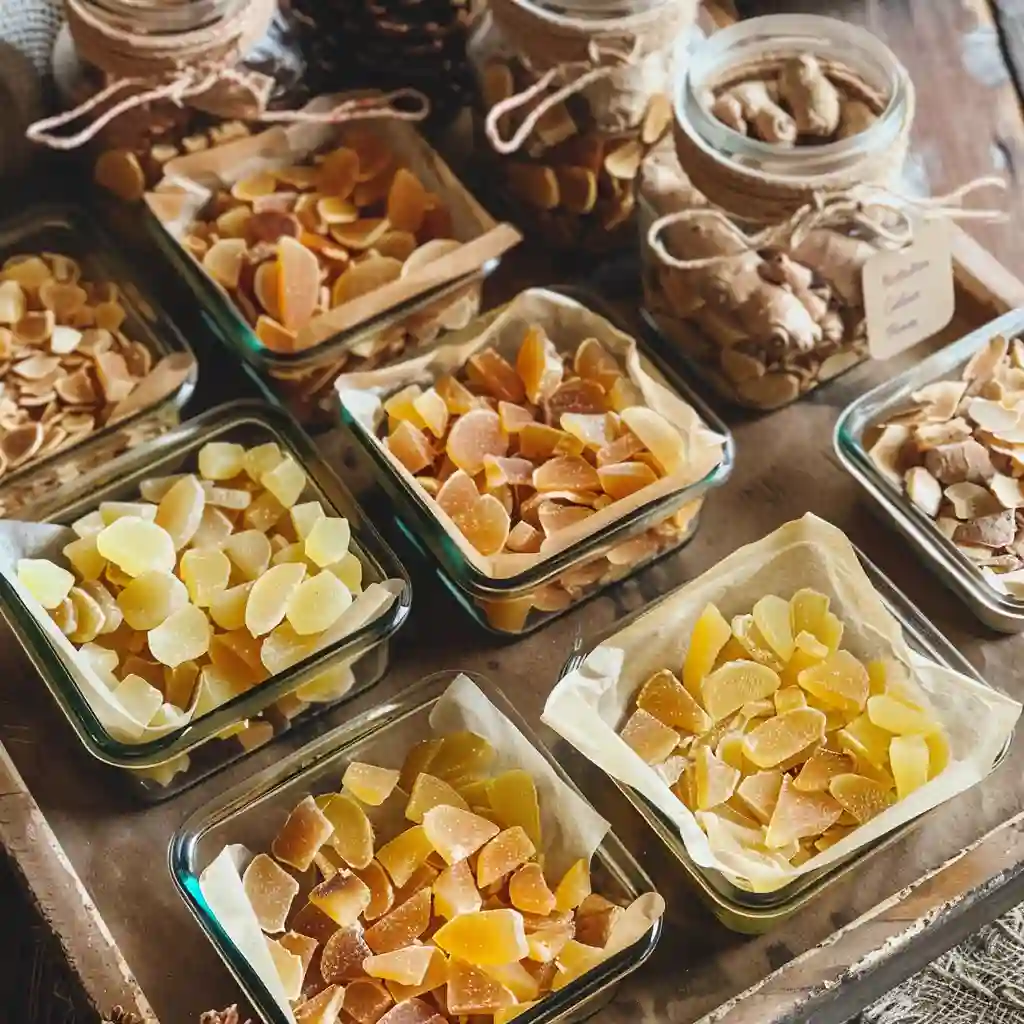
What’s the Easiest Way to Chop Candied Fruit? Pro Hacks
Over time, I’ve collected a few essential tricks that make chopping easier and cleaner. Whether you’re working with peels, pineapple chunks, or mango strips, these tips will turn your Candied Fruit Hack into a smooth process.
1. Freeze Briefly Before Chopping
Pop your candied fruit in the freezer for 10–15 minutes. It firms up just enough to slice cleanly without turning brittle.
2. Use an Oiled or Powdered Knife
Coat your knife with a neutral oil (like avocado) or lightly dust it with powdered sugar or cornstarch. This helps prevent the sticky coating from building up. Wipe and re-coat as needed.
3. Use Kitchen Shears Instead of a Knife
Yes—scissors! Food-grade kitchen shears glide through sticky pieces, especially soft ones like cherries or kiwi.
4. Chop on Parchment or Silicone
Avoid wood and porous surfaces. Use parchment paper or a silicone mat to keep the mess contained and the cleanup quick.
Want to see this trick in action? I used chopped candied mango in my Hong Kong Style French Toast, and the fruity upgrade was next-level.
Tools and Techniques to Keep It From Sticking
Here are a few more strategies I rely on to make each Candied Fruit Hack batch easier to handle and store:
| Problem | Fix | Best Tool |
|---|---|---|
| Knife sticks to fruit | Oil or sugar-dusted blade | Sharp chef’s knife |
| Fruit sticks to board | Use silicone or parchment | Silicone cutting mat |
| Uneven sizes | Freeze before chopping | Ruler + chef’s knife |
| Sticky to measure | Toss in flour or sugar | Mixing bowl & spoon |
When storing chopped fruit, toss it with a little cornstarch or powdered sugar. Then seal it in an airtight container to keep the pieces separate and ready for baking or snacking.
Want to see chopped fruit in action? Don’t miss our Strawberry Angel Food Cake, where bits of candied strawberry add a chewy, fruity finish.
Crystallized Fruit vs Candied Fruit
Before I got into this sweet little world of sugar and fruit, I used to think “candied” and “crystallized” were the same thing. But once I started experimenting with my own Candied Fruit Hack, I quickly realized they’re quite different. Both are sugary, both are delicious—but how they’re made, stored, and served can make a world of difference.
What Fruits Can Be Crystallized and How It’s Different
Crystallized fruit is essentially candied fruit that’s been rolled in sugar while still slightly moist. This creates a crunchy outer layer and extends its shelf life. It’s sparkly, textured, and makes for a stunning edible garnish or holiday candy.
Here’s how crystallized fruit differs from the version made with a typical Candied Fruit Hack:
| Feature | Candied Fruit | Crystallized Fruit |
|---|---|---|
| Final Texture | Sticky or chewy | Dry, slightly crunchy |
| Sugar Treatment | Syrup-infused | Syrup-infused + sugar-coated |
| Appearance | Glossy | Sparkling, frosted look |
| Use | Baking, snacking, topping | Garnishes, holiday décor, standalone candy |
Crystallizing is like adding the final sparkle—it takes your fruit from good to gorgeous.
Fruits That Crystallize Well:
- Ginger: Spicy and chewy with a crisp finish.
- Citrus Peels: Especially orange and lemon, great for cocktails and cakes.
- Pineapple: Sweet, tart, and firm enough to handle coating.
- Cherries: Bright, tangy, and beautiful when dipped in chocolate.
One of my favorite crystallized fruit discoveries? Ginger rolled in raw cane sugar from a dessert café in Chiang Mai. It had spice, crunch, and just enough sweetness to keep me hooked.
When to Use Crystallized Fruit Instead of Candied Fruit
Although they can sometimes be swapped, each version has its strengths depending on your goal—or which Candied Fruit Hack you’re working with.
Use Crystallized Fruit When:
- You want a crunchy contrast to soft desserts
- You’re decorating cookies, cakes, or breads
- You’re gifting or serving it solo like traditional candy
Use Candied Fruit When:
- Mixing into batters for cakes, muffins, or quick breads
- Adding chewy texture to snack bars or granola
- Layering flavors with syrup, spices, or fruit glazes
Want to taste the difference yourself? Try our Chocolate Tiramisu with chopped candied citrus instead of traditional toppings. It’s a next-level twist straight from my Candied Fruit Hack playbook.
My Favorite Homemade Candied Fruit Recipes
Over the years, experimenting with my own Candied Fruit Hack has led to some real kitchen gems. These two recipes are my all-time favorites—not just because they’re simple and foolproof, but because they showcase the beauty and flexibility of candying fruit at home.
Citrus Peel Candy the Sifaw Way
This recipe is where my obsession with the Candied Fruit Hack began. One winter in Fez, Morocco, I tasted a sliver of candied orange peel dusted with sugar and kissed with cinnamon. That single bite sealed the deal—I was hooked for life.
Ingredients:
- 4 large oranges (or lemons, grapefruit)
- 2 cups granulated sugar (plus more for coating)
- 1 cup water
- 1 tsp lemon juice
- Optional: cinnamon stick or clove
Instructions:
- Peel the fruit into wide strips, avoiding too much white pith.
- Boil the peels in water for 10 minutes to soften and remove bitterness. Repeat twice with fresh water.
- In a saucepan, combine sugar, water, and lemon juice. Bring to a simmer.
- Add the peels and simmer on low for 45–60 minutes until they become translucent.
- Remove with tongs and dry on a rack for at least 6 hours.
- Toss in sugar for a crystallized finish or leave plain for a glossy chew.
These make stunning edible gifts or cocktail garnishes. Try them on our Matcha Cupcakes for a sharp-sweet contrast that really sings.
Tropical Mango Candies You’ll Want Year-Round
I started making these after a trip to the Philippines, where I bought too many ripe mangoes from a local market. A little chili and lime transformed this Candied Fruit Hack into a bold, tropical treat.
Ingredients:
- 2 ripe but firm mangoes
- 1.5 cups sugar
- 1/2 cup water
- 1 tbsp lime juice
- 1/2 tsp chili flakes (optional)
Instructions:
- Peel and slice the mangoes into thick strips.
- Combine sugar, water, and lime juice in a saucepan. Bring to a boil, then reduce to a simmer.
- Add mango and cook for 30–35 minutes, until syrup thickens and slices are glossy.
- Remove with a slotted spoon and dry on a rack.
- Sprinkle with chili flakes and sugar while drying for a sweet-spicy finish.
These are addictive and perfect for summer desserts or yogurt bowls. Don’t miss pairing them with our Mango Pudding for a double-mango moment powered by your best Candied Fruit Hack yet.
PART 9: How to Use Candied Fruit in Everyday Cooking
Now that you’ve nailed the candied fruit hack, you might be wondering—what do I actually do with it? That’s where things get exciting. Once you’ve got a stash of this sweet magic, there are countless ways to sneak it into your cooking, elevate everyday recipes, and impress guests with just a handful of colorful, chewy fruit.
Baking, Garnishing, and Gifting Ideas
I’ve learned that candied fruit can transform even the most basic treat into something special. It’s not just about sweetness—it’s about color, texture, and unexpected flavor bursts.
Add It to Your Baking
Candied fruit is a baker’s dream. Here are a few ideas:
- Fold it into muffins or cupcakes: Adds chew and color.
- Mix into quick breads: Banana or pumpkin bread with candied citrus is next-level.
- Sprinkle on cookies before baking: For a jeweled effect and a chewy topping.
- Use it in holiday bakes: A perfect stand-in or upgrade for fruitcake, panettone, or stollen.
Try using chopped candied fruit in our Chocolate Tres Leches for a fusion twist that balances richness with zesty sweetness.
Garnish Like a Pro
Use candied fruit to:
- Top yogurt or smoothie bowls.
- Decorate cakes, cheesecakes, and tarts.
- Add a pop of flavor to cocktails.
I love using candied citrus curls or mango slices to decorate the edges of my Mango Pancake stack—it turns brunch into a showstopper.
Make It a Gift
Package your homemade candied fruit in mason jars, wrap them with twine, and you’ve got a thoughtful, handmade gift that lasts. Add a tag with pairing suggestions like tea, cheese, or chocolate.
How to Elevate Simple Desserts with Candied Fruit
Here’s where your imagination—and pantry—get to play.
| Dessert | Candied Fruit Pairing | Why It Works |
|---|---|---|
| Cheesecake | Candied ginger or mango | Cuts through richness |
| Ice cream | Chopped citrus peel | Adds texture and zing |
| Pound cake | Mixed candied fruit glaze | Boosts visual appeal and flavor |
| Hot chocolate | Candied cherry skewer | A playful, edible stir stick |
| Oatmeal | Chopped mango and pineapple | Brightens breakfast naturally |
You can even press bits of candied fruit into frosting or dough just before baking to lock in flavor and sparkle.
One of my proudest creations? Using leftover candied orange and ginger from testing this recipe to top our Matcha Tres Leches—it added contrast and a layer of storytelling to a cake that was already a star.
FAQs About Candied Fruit Hack (PAA)
Why won’t my candied fruit harden?
The syrup might not have reached the soft-ball stage, or the fruit was too wet. Let it simmer longer or dry in a low oven.
What is the easiest way to chop candied fruit?
Slightly freeze it, then slice with a greased or powdered knife. Kitchen shears also work like a charm.
What fruits can be crystallized?
Ginger, citrus peel, pineapple, and cherries are all great options. Crystallizing adds texture and extends shelf life.
What do I need for candied fruit?
Fruit, sugar, water, and a little patience. A thermometer, cooling rack, and storage jars help too.
Conclusion
So there you have it—my complete, no-fail guide to mastering the Candied Fruit Hack. From sticky mistakes to glittering successes, every batch has taught me something sweet (and often humbling) about patience, flavor, and the joy of creating.
Whether you’re layering it into dessert, gifting it to a friend, or simply snacking on your own creation, candied fruit is more than a treat—it’s a celebration of your time and craft.
If you’re ready to take this further, don’t miss our full tutorial on Tanghulu Candied Fruit Skewers—it’s a crunchy, glossy cousin to today’s technique.
Follow me on Facebook and pin this post to your Pinterest board to keep your candy game strong and sweet!
